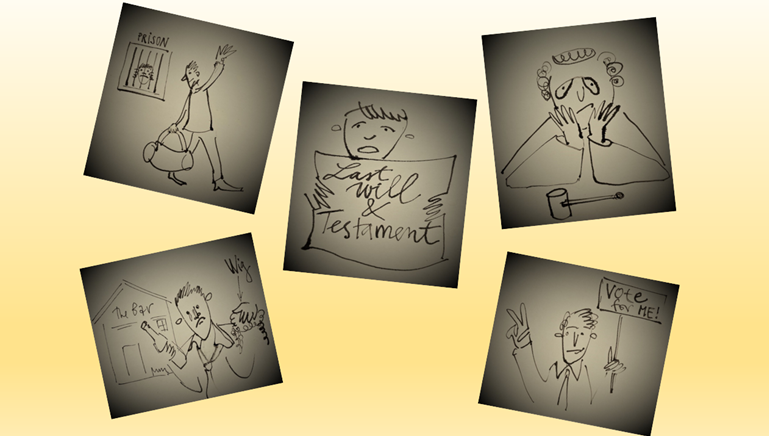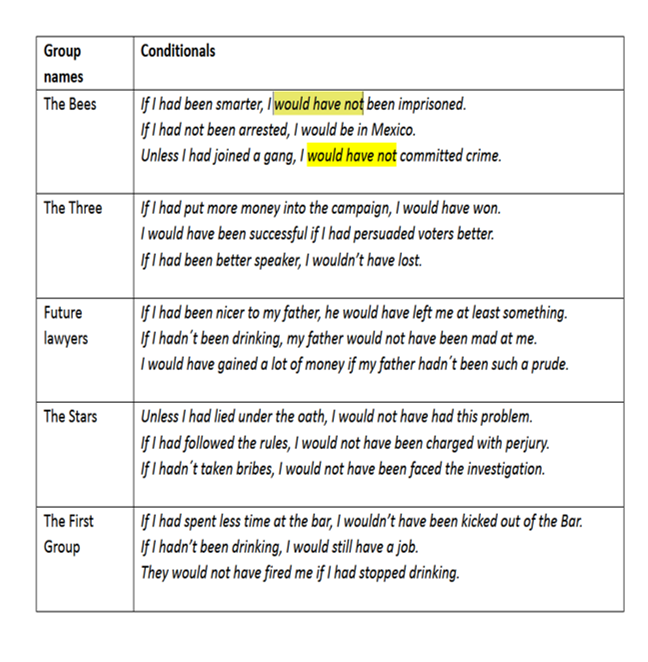Disbarred Barristers and the Like: A Creative Take on the Third Conditional
Štěpánka Bilová, Radmila Doupovcová and Barbora Chovancová are teachers of English for Lawyers at Masaryk University Language Centre in Brno, Czech Republic. All three are involved in material design. They promote student autonomy and motivation and are also interested in innovation and creativity. Recently, together with other colleagues from the department, they have published a book of texts and accompanying activities entitled Právnická angličtina (Legal English) aimed at Czech lawyers, law students, translators and other professionals interested in the language of law. Emails: stepanka.bilova@law.muni.cz, radmila.doupovcova@law.muni.cz, barbora.chovancova@law.muni.cz
Aim of the lesson
- To practice the third conditional in Legal English (or elsewhere: any other area of ESP or general English) in writing in a playful way.
- Vocabulary revision and recycling (collocations of adjectives and nouns describing people, in our case legal terms, e.g., disbarred barrister, or other relevant terms, e.g., failed candidate).
- To promote student motivation, creativity, autonomy and well-being.
What is needed
- Cards with pictures or photos of people and two-word descriptions of those people relevant to the topic your class is dealing with. Our context is Legal English, namely people involved in law and law-related adjectives (e.g., impeached judge, disbarred barrister).
- To pre-teach the rules for the third conditional.
Procedure
Step 1 – Groups of students receive one card each with a picture and a two-word description of a specific person (e.g., disinherited heir). On paper or in a shared document, the groups write 3 conditional sentences expressing regrets the person might have about their past. It is forbidden to use the words from the two-word descriptions.
Students find the third conditional difficult and despite having all the rules, they still make mistakes. An unintrusive way to help them create grammatically correct sentences is for the teacher to monitor their work and highlight the problem areas and identify the type of problem (e.g. word order) and let them correct themselves. See Figure 3 with the example of students’ work in a shared document.
Figure 1. Picture cards (In class we use cartoons, but for copyright reasons we had illustrative pictures drawn specially to accompany this article. You can use photos of people relevant to your own teaching context.)
|
DISINHERITED HEIR |
|
IMPEACHED JUDGE |
|
EX-CONVICT |
|
FAILED CANDIDATE |
|
DISBARRED BARRISTER |
The following instructions were given to the students on a PowerPoint slide:
|
The person on your card is reminiscing about his past with regret. What mistakes did he make? What could have been different only if...?
|
Step 2 – The groups then share their sentences and the rest of the class, while looking at all 5 of the pictures (without the two-word descriptions), tries to guess who the person is. Ideally, they produce the exact collocation according to the cards. Though the phrases may sound technical and complicated, the students should be able to do so having come across them in previous classes, maybe in different combinations.
Option A – The groups in the audience make notes of their guesses (number of the picture and the two-word description), the group that gets most of the answers right is the winner.
Option B – Students shout out their guesses. If necessary, the authors of the sentences and/or the teacher help to elicit the “right” wording from the class. Sometimes this activity produces extensive lists of synonyms and related vocab.
Figure 2. Slide with pictures without the descriptions

Figure 3. Examples of authentic student work in groups and teacher’s assistance in a shared document

Please check the Pilgrims f2f courses at Pilgrims website.
Please check the Pilgrims online courses at Pilgrims website.
Business News: A Short Activity for Students of Business English
Ladislav Václavík, the Czech RepublicDisbarred Barristers and the Like: A Creative Take on the Third Conditional
Štepánka Bilová, the Czech Republic;Radmila Doupovcová, the Czech Republic;Barbora Chovancová, the Czech RepublicCreative Group Exercises as an Educational Tool in Teaching Professional Language
Natália Gachallová, the Czech Republic;Andrea Salayová, the Czech RepublicInternationalizing the (Legal Spanish) Curriculum – Three Activities to Nurture Motivation and Intercultural Competence
Veronika De Azevedo Camacho, the Czech RepublicAsking the “Big Questions” about Academic Writing: A Lesson Plan and Some Reflections
Joe Lennon, the Czech RepublicAuthenticity in Teaching ESP Genre-Based Writing – When Does It Work?
Veronika Dvorácková, the Czech RepublicWhere to Start? Discussing Academic Writing
David Zelený, the Czech Republic